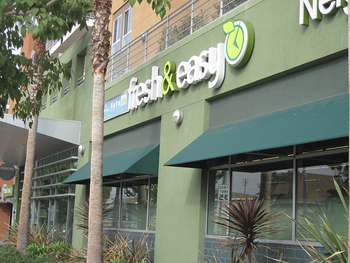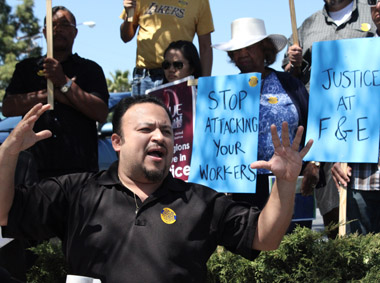Listen to an audio story from Annenberg Radio News
 For many shoppers around LA, “Thank you for shopping at Fresh & Easy” has become a familiar sound.
For many shoppers around LA, “Thank you for shopping at Fresh & Easy” has become a familiar sound.
British supermarket chain Tesco started opening Fresh & Easy neighborhood markets in California, Arizona and Nevada in 2007. In LA, the chain has opened stores in several under-served neighborhoods.
“I used to go to Food 4 Less to buy my meats, but now I come here because, heck, it’s good. The meat, the chicken, here it’s tender, over there it’s hard. I couldn’t even eat the meat over there anymore,” said Manny Castro, a regular at the Fresh & Easy on East Adams and Central in South LA. Fresh & Easy also has locations in Huntington Park and Compton and had proposed a store in Crenshaw which never opened because of building restrictions in the neighborhood.
In these neighborhoods, convenience stores and discount grocers abound, but big stores like Ralph’s, Vons or Albertson’s are scarce. Public policy experts refer to areas like South LA, where access to fresh produce is limited, as “food deserts.” For many, Fresh & Easy offered a nice oasis.
Richard Cuevas shops at the East Adams Fresh & Easy several times a week. “It’s one of my favorite stores actually, the quality of all their stuff that they carry is fresh, I like it. Actually the name really goes for it–it’s fresh and easy,” he said.
In five years, Tesco opened 199 Fresh and Easy markets in the US. Now all of those stores could close. Philip Clarke, CEO of Tesco said Wednesday, “It’s likely, but not certain, that our presence in America will come to an end.”
Tesco has 500,000 employees in 14 different countries but business in the USA has not be going well.
Manny Castro says of the East Adams Boulevard Fresh & Easy, “This one’s been dead.”
Fresh & Easy already closed seven locations in California earlier this year. Now, Castro hopes his Fresh & Easy isn’t going anywhere. “This is the best store in the neighborhood, better than going to the market. The parking, everything, you know, it’s perfect,” he said.
It is not clear yet whether Tesco will sell their American stores or just close them down.









 Outside the Fresh & Easy Neighborhood Market in Eagle Rock, 60 labor activists and grocery store employees lined up on the sidewalk to rally today against unsafe working conditions and alleged union-breaking tactics at the store.
Outside the Fresh & Easy Neighborhood Market in Eagle Rock, 60 labor activists and grocery store employees lined up on the sidewalk to rally today against unsafe working conditions and alleged union-breaking tactics at the store. “To me that open door policy is not really in force,” responded Acuna. “I feel like it’s not open to freely say what you want. I feel like whatever you say can be used against you.”
“To me that open door policy is not really in force,” responded Acuna. “I feel like it’s not open to freely say what you want. I feel like whatever you say can be used against you.”




